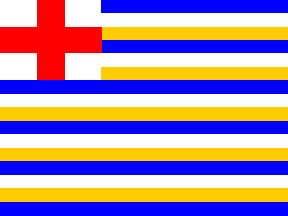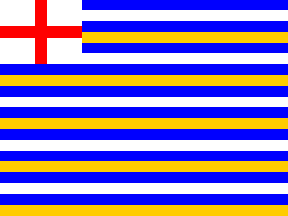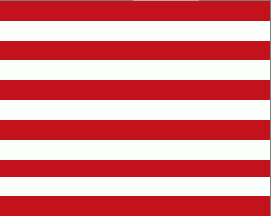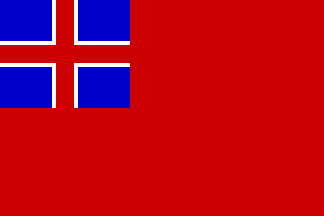![[1707 union jack]](../images/g/gb-uf-1707.gif) image by Pete Loeser, 27 February 2020
image by Pete Loeser, 27 February 2020
Last modified: 2020-03-21 by rob raeside
Keywords: united kingdom | union jack | civil ensign | naval ensign | red ensign | white ensign | blue ensign |
Links: FOTW homepage |
search |
disclaimer and copyright |
write us |
mirrors
In 1603 the House of Stuart replaced the House of Tudor as England´s ruling family with Elizabeth's death. James VI of Scotland became James I of England. Around 1620 we began to see the striped Tudor ensign begin to give way to new naval ensigns with solid-color fields. However, some naval ensigns using the Tudor striped format were reported still in use in the late 1620s, and some parts of the merchant service even longer. An example would be the red and white striped ensign of the East India Company, which was still in general use by ships of that company in 1673.
Pete Loeser, 5 May 2013
It is worth remembering that the United Kingdom of Great Britain was not created until the Act of Union in 1707, and until that date England and Scotland were separate countries although sharing a monarch from 1603. Of course, the tiny Scots navy (three ships in 1707) was entirely subsumed by the vastly larger English Royal Navy, and the traditions of this latter adopted without alteration so the two sets of flags are inextricably linked.
Chris Southworth, 18 February 2020
According the both Perrin and Wilson the proportions of English ensigns (although without citing any sources) in the late 16th Century were "squarish", and I have no reason to doubt this statement; however, for just how long this situation continued is open to conjecture. All we can be sure of is that by 1687 the ratio of ensigns had lengthened to 11:18 (Pepys), but when this change occurred is (at least as far as I can discover) unknown.
Christopher Southworth, 2 March 2020
![[1707 union jack]](../images/g/gb-uf-1707.gif) image by Pete Loeser, 27 February 2020
image by Pete Loeser, 27 February 2020
With King James IV of Scotland inheritance of the English throne in 1603, the Cross of Saint George was placed over the Scottish Cross of Saint Andrew to form the British Union Flag. Although the traditional St. George's Cross flag continued to be used at sea as the English flag for some years, gradually all seagoing ships began using the new Union flag (Union Jack). It is also important to note here that the St. George's Cross flag might have been, in effect, the English national flag, but was not called a national flag.
The noted flag scholar, W. G. Perrin, said in his British Flags (1922) "By the end of the sixteenth century...the flag of St George had taken the lead as the distinguishing characteristic of English ships, both men-of-war and merchantmen." This would change, however, with the introduction of the King's Colours.
In 1634, the Union Jack was made the official ensign of the Royal Navy, its use by merchant ships was forbidden, and its use was restricted to only the King's government and officials. By 1707, however, the Union flag had also became a defacto British national flag. Following the Treaty of Union and Acts of Union in 1707, the Union Flag had gained the status of "the ensign armorial of Great Britain", for the newly created state. It was to be later adopted by land forces, although the blue of the field used on land-based versions more closely resembled the blue of the flag of Scotland as illustrated for the Union Jack/Flag of 1707.
However, this said, the use of the Cross of Saint John continued to dominate most Royal Navy Squadron Ensigns during the early 17th Century.
Text from: Historical Flags of Our Ancestors
Pete Loeser, 22 February 2020
![[Baffin ensign, 1615]](../images/g/gb~1615.gif) image by Tomislav Todorović, 21 March 2007
image by Tomislav Todorović, 21 March 2007
(Editorial Note: Although not a Tudor Ensign, the ensign used by the Baffin Arctic Expedition in 1615 followed the established Tudor naval pattern)
Another striped ensign is shown on the map which William Baffin made during his Arctic explorations in 1615 and which is now kept in the British Museum, London. It was used there to mark two landing points. Its field consists
of nine stripes in red, blue, red, green, red, blue, red, green and red colours, respectively from top to bottom. The canton is charged with the Cross of St. George and is as wide as four stripes together.
Source: Istorija otkrića i istraživanja, vol. V: Poslednje granice Zemlje. Mladinska knjiga, Ljubljana, 1979
Original title: A History of Discovery and Exploration, Vol. V: Earth's Last Frontiers © 1973 Aldus Books Limited, London
Tomislav Todorović, 21 March 2007
 #1
#1
 #2
#2
Speculative images by Željko Heimer
We know from Perrin (British Flags) that the Red Ensign began to replace the striped design in Navy Royale service from 1625 onwards, and that those stripes had been in blue, white and yellow, however, this Perrin does not give us the number of such stripes, the size of the canton or the width of the St. George's Cross. From it none-the-less, we can be certain that they had been completely superseded by 1633 (a survey of stores at Deptford carried out in April of that year).
These images must be considered, therefore, to a certain degree speculative, however, they are based upon illustrations in two related, but non-specific works (The Fighting Ship in the Royal Navy and Dictionary of Sea Painters, both by E.H.H. Archibald), and upon a picture in the National Maritime Museum - The Return of Prince Charles from Spain, 5 October 1623 by Hendrick Cornelisz Vroom.
Christopher Southworth, 28 April 2013 and 5 May 2013
 #3 -
speculative image by Klaus-Michael Schneider
#3 -
speculative image by Klaus-Michael Schneider
I made another drawing of the ensign (#3) according to E.H.H. Archibald´s Dictionary of Seapainters. The ensign is depicted in the plate opposite to p.20 as flag no. 27. The golden stripes in my edition are very thin, the golden colour looks somehow brownish. Maybe, the width is slightly bigger than in my rendition.
Klaus-Michael Schneider, 29 April 2013
The illustration in Archibald's book matches the painting as far as one can see, and one might presume that the top and bottom are therefore also correct. This being so, the sequence of stripes from top to bottom (b = blue, w = white, y = yellow) should be: b-w-b-y-b-w-b-y-b-w-b-y-b-w-b-y-b-w-b-y, with the canton extending down to the top of the fourth blue stripe. Putting it in another way; it is a white flag with four sets of blue/yellow/blue stripes, a blue stripe at the top, and a blue and a yellow stripe at the bottom.
David Prothero, 29 April 2013
Željko's first image (#1) definitely follows Archibald's illustration, and as you said David, the painting is not terribly clear. Vroom's is the earlier image, of course, but this was painted some years before the Dutch tradition of accuracy in this type of genre was definitely established, and I am inclined, therefore, to (err on the safe side and) suggest that FOTW offers both as alternatives?
Christopher Southworth, 29 April 2013
The first image (#1) does not follow the illustration in my copy of The Fighting Ship (1984) by E.H.H. Archibald, curator of oil paintings at the National Maritime Museum. The second image (#2) does, although it might be better with a narrower St George's cross, as in Klaus-Michael's image (#3). An image based on a contemporary painting, which may, or may not, be particularly accurate, is better than an image that is not?
David Prothero, 30 April 2013
It would appear that Archibald revised his images between that in the 1972 The Wooden Fighting Ship in the Royal Navy I was using, and your 1984 tome? We must therefore (and as you suggest) go with the second image. Since Željko's gifs with the wider cross were also based upon the 1968 image, I must also agree with you that this should be narrowed also.
It is a moot point - at least at this early date - about the use of contemporary images as a basis for flag reconstruction, however as you say, however accurate or otherwise it might be, it's better than somebody's second-hand interpretation? Not that I am questioning Mr Archibald's scholarship or his expertise, it is merely a case of primary as against secondary sources, and (in addition to rewriting my notes) I will ask Željko
to narrow the cross.
Christopher Southworth, 30 April 2013
All is explained, I think. My copy The Fighting Ship in the Royal Navy combines into one volume, two books, The Wooden Fighting Ship in the Royal Navy and The Metal Fighting Ship in the Royal Navy, previously published separately. I assumed that the first part of "The Fighting Ship ...", that dealt with wooden ships, was the same as the book "The Wooden Fighting...", but it is apparently different in some respects. I take it that the attached .jpg of the ensign on the "Prince Royal" is different to the ensign in "The Wooden Fighting Ship"?
David Prothero, 1 May 2013
Coincidentally or not, there's a Dutch pattern from the 80 Year War of a white flag with alternating orange and blue stripes that are a stripe's width apart. That would give the two a similar structure in more or less the same time frame. Whose influence is this on whom?
The 1984 interpretation I find unlikely. If the blue stripes are little more than edges, they'd be either on both the top and bottom or on neither. Look at Michael's version, where the ochre is just edges. It's only in between, connecting breadths of cloth as it were. Still, if Archibald had the painting at hand...
We really do need flag shots of these paintings; high-resolution of the entire painting just doesn't do it. Is this painting on display and is there someone near it who could shoot the flags, if permitted?
Peter Hans van den Muijzenberg, 23 August 2013
 image by Klaus-Michael Schneider, 8 May 2013
image by Klaus-Michael Schneider, 8 May 2013
An 11-stripes flag divided horizontally into alternating red and white stripes, according to source flown in the early 17th Century.
Source: E.H.H. Archibald: Dictionary of Sea Painters, flag chart opp. to p.20, flag nos. 25 (Tudor) and 26 (Stuart).
Klaus-Michael Schneider, 8 May 2013
Nathan Lamm asked, "How was the white altered? I hadn't thought the large cross was added that early [1702]."
According to Perrin (1922), the change in white command flags was contemporary with the change in the white ensign of February 1702. At first admirals of the white squadron were instructed to fly
the Union as a command flag, however, by orders issued on 6 May 1702 this was amended to a white flag "with a large St George's Cross". (On the evidence of paintings) the cross had narrowed by 1710, and so it has remained to this day (becoming the command flag of a full admiral c1870 with the increasing demise of the sailing navy - confirmed in 1898).
Christopher Southworth, 29 June 2003
Based on descriptions in Wilson's Flags at Sea
 Cross of Saint George c1277
Cross of Saint George c1277
![[possible Elizabethan ensign]](../images/g/gb~eliz3.gif) Tudor Ensign 1485-1603
Tudor Ensign 1485-1603
Wilson's Flags at Sea (1986) has a black and white image on page 15 and states on page 14:
"By the end of the (16th) century striped ensigns were common on European ships and those of English ships were often distinguished by a cross of St. George in a canton or overall. To judge from the scattered evidence of illustrations, the colors of ensigns varied from ship to ship: although red and white (the colors of the cross of St. George) and green and white (the Tudor's livery colors) were used, there seems sometimes to have been no significance in the colors chosen."Although no blue stripes are mentioned they may be implied by 'varied'; furthermore in old flag charts the colors blue and green were often confused with each others.
Before then English merchantmen had often flown the Union, and before 1606 the plain Cross of St. George. However, there is an older English flag with a canton - the Tudor naval ensign, which was alternating green and white
horizontal stripes (the livery colours of the Tudor family) with St. George in a square canton. I don't recall if there was a set number of stripes - I suspect not, but nine rings a bell. There is a reproduction of this flag
displayed on the upper floor of the Victory Gallery of the Royal Naval Museum in Portsmouth along with a number of other flags from the Royal Navy's history.
Roy Stilling, 8 February 1996
Stern Ensigns were, according to Perrin, a rather late entrant on the English naval scene and he gives a date of around 1574. Prior to this a simple Cross of St George would be flown, or perhaps the Royal Arms in addition to a great number of streamers and other banners.
As far as the introduction of plain ensigns is concerned: Prior to c1625 English Royal Naval Ensigns were striped in various colours (green and white, red, white and blue, gold, white, and blue etc.,) with a white canton and red Cross of St George (or occasionally with a Cross of St George overall). Merchant ensigns were either striped with a St George canton (that of the Honourable East India Company is a survival from that age) or a simple cross of St George on a white field - if, that is, a stern ensign was carried at all, since a masthead flag of St George was the older form of recognition. The exact date of introduction of the red ensign is slightly uncertain, however, it is known that the recommendation was made in 1625 and that the striped ensigns had become obsolete by 1630 (for warships). The white and blue ensigns were introduced for all naval ships by an Order of the Navy Commissioners in 1653.
Christopher Southworth, 24 February 2003
The Royal United Service Institution's Journal of 1880 contained an article entitled The Heraldry of the Sea by J.K. Laughton, Lecturer on Naval History at the Royal Naval College. It included the following passage:
"..., and the tactical necessities of large fleets led to their divisions and subdivisions being distinguished, each by its own flag. In this the English Admiralty was beyond doubt guided by the usage within the Straits, amongst the Venetians or Genoese: in accordance with which the fleet was divided into three squadrons - the centre or red, the van or blue, and the rear or white-..."
Is anyone able to confirm that this was indeed the way in which the Genoese and Venetian fleets were organized?
David Prothero, 31 October 2014
 #1
#1
 #2
#2
images by Tomislav Todorović, 9 May 2013
Fredrick Hulme briefly mentioned these two Royal Naval flags as coming from "a sea piece of the Sixteenth Century." The first (#1) appears to be an early version of the Red Ensign and was displayed at the poop of a unidentified ship in the picture, while the second was displayed like a naval Jack on the bowsprit of the same ship, but appearing very much like an early prototype for the Union Flag.
Source: The Flags of the World (1896) by Frederick Edward Hulme, Chapter 2
Image Source: Plate Eight
Pete Loeser, 9 May 2013
I have a copy of Hulme in my collection and have seen these two before, and I'm afraid I take them with a pinch of salt for at least two reasons: a) this is before the joining of the two crowns (England and Scotland), so they couldn't possibly be a prototype of the Union Flag, and b) the tradition of accuracy in marine paintings had not yet been established and the actual designs are quite likely to be a product of the artists imagination? Having said all that, the freedom of design which characterized sea flags in the Tudor era could well have yielded such a pair of oddities?
Christopher Southworth, 10 May 2013
While the jack was (almost certainly) not the prototype for the Union Flag, the ensign, if its existence could be verified, would have been the precursor of the modern Red Ensign - it would prove that the basic design, along with a multitude of others, was already used in the Tudor era.
Tomislav Todorovic, 10 May 2013
It is, to say the least, highly unfortunate that we cannot trust 16th Century illustrations with regard to flags, however, to show the basic design of a Red Ensign at least 25 years before such a thing was officially adopted (1625 or immediately thereafter) is a reasonable indication of design trends. I cannot agree with you that it actually "proves" anything Tomislav, but even given the lack of reliability in the source, the idea behind it must have come from somewhere?
It is true that we have written proof of the basic designs (e.g., "a banner with a Rose of white and green") of Tudor flags as they were supplied to various of the Royal Fleet, but what visual records we have for the period are considered somewhat unreliable. Having said that, they are all we've got as to what these ensigns, streamers and banners actually looked like, and an "unreliable source" is better than none (at least in my opinion).
Christopher Southworth, 10 May 2013
The purpose of naval ensigns in the 16th century (as now) was unmistakable recognition by all at sea and on land who might encounter the ship. The Royal Navy did not yet roam the seven seas, but it certainly encountered many foreign friendlies and hostiles. Surely most of these ships and coastal forts, at least in Europe, knew how to recognize RN ships. How did they do this? Artists may be whimsical and unreliable, but there must have been other sources, not to mention the designing and issuing authorities. I have little knowledge of 16th century naval matters, so my question is: has this been exhaustively researched?
For military land forces, the proposition is slightly different. Flags were company/regimental for its members to rally around and follow signals. Since colonels owned their regiments, there was little higher regulatory authority in the 16th-17th centuries, and most flag designs have been lost when the flags themselves disappeared. Foreigners did not really need manuals of recognition for such flags, so what survives was produced more for and by the historically-minded.
T.F. Mills, 10 May 2013
History of British Naval Ensigns Part 2 - 1625 to 1799